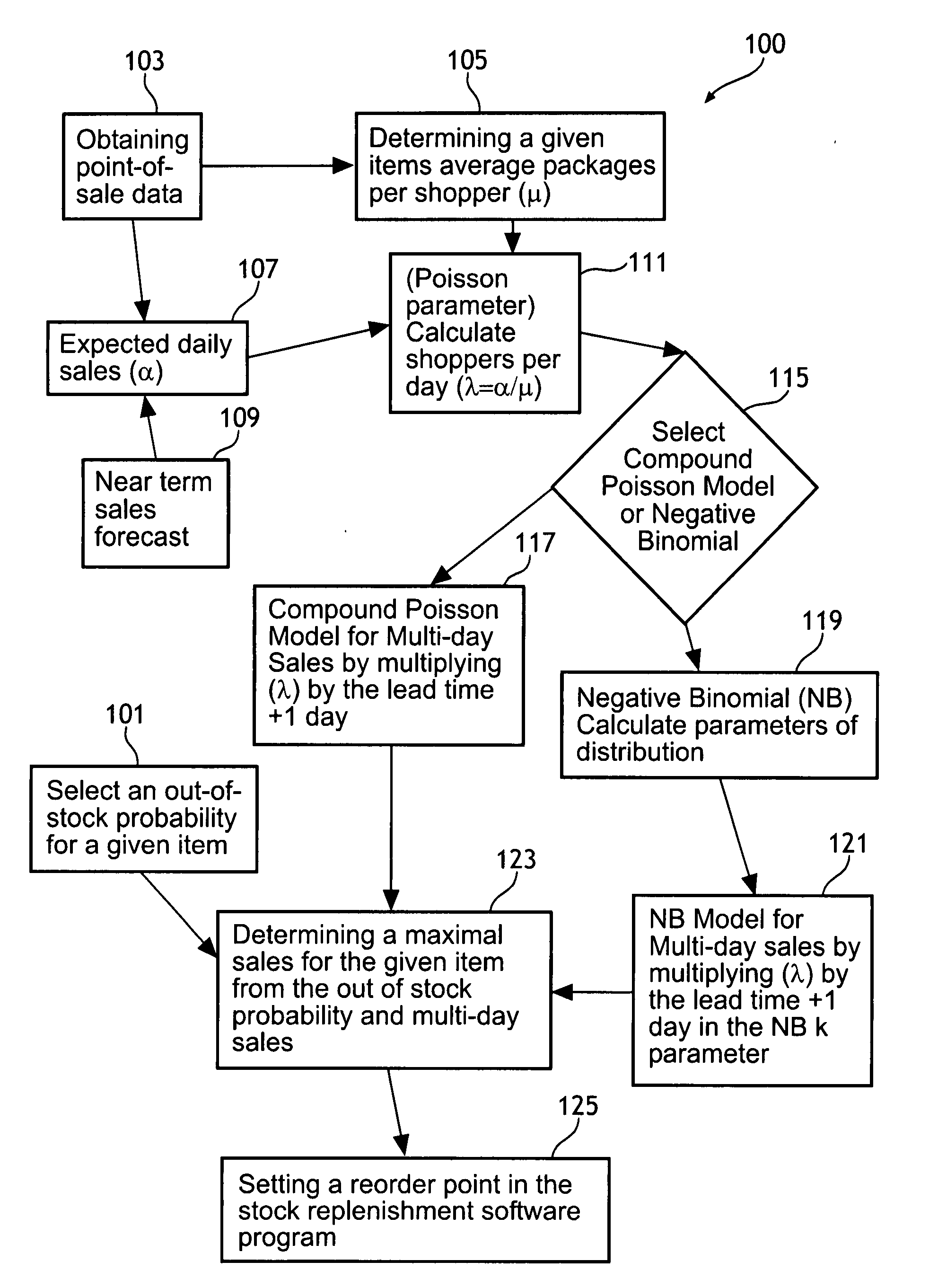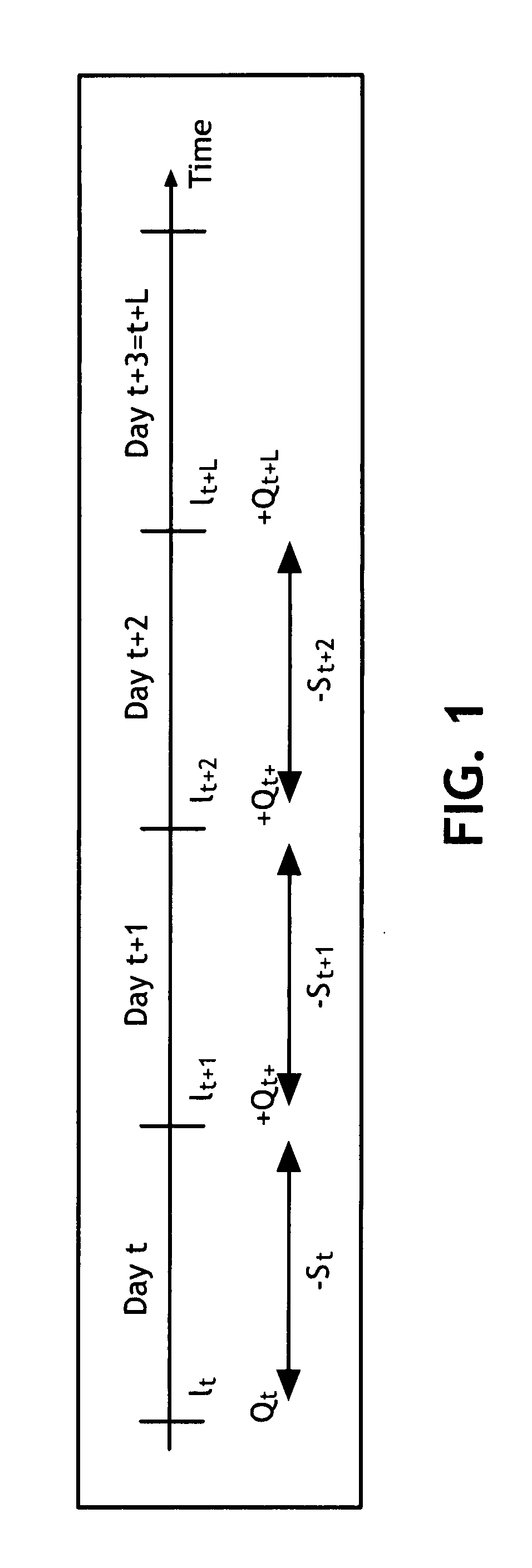System and method for managing a collection of stock replenishment systems
a technology of stock replenishment and management system, which is applied in the field of system and method for managing a collection of stock replenishment system, can solve the problems of losing the sale of the branded product for both the supplier of the branded product and the retail store selling the product, the manufacturer or supplier of the original product the consumer desired to purchase loses the sale of the product, and the retailer may lose the consumer to another retail competitor
- Summary
- Abstract
- Description
- Claims
- Application Information
AI Technical Summary
Benefits of technology
Problems solved by technology
Method used
Image
Examples
example 1
[0101]This Example illustrates a low-velocity daily sales situation. Table 1 shows the number of Items Sold on a given day for a period of ninety days.
TABLE 1(Daily Sales)DayItems Sold112031415060718290101112121130142151162171182191201210222232240252260271280292300313321330340351360370381391402410420431440450460470481491500511522530540550560571581590602611620633641650661670681693700710720731740751762771780791802810820833841851860870882890900
[0102]From the point-of-sale data, the average daily sales were determined to be 0.81 packages per day. In addition, the packages per shopper histogram had a distribution shown in Table 2.
TABLE 2(Packages per Shopper Histogram)Packages per Shopper12345% of Baskets97.4%2.3%0.2%0.0%0.0%
[0103]Analysis of the packages per shopper histogram showed that the average packages per shopper (μ) was 1.03 with a standard deviation (a) of 0.20. From this information, the Average Shoppers per Day (λ) is calculated from the Average Daily Sales and the Average Pa...
example 2
[0107]This Example illustrates a high-velocity daily sales situation. Table 3 shows the number of Items Sold on a given day for a period of ninety days.
TABLE 3(Daily Sales)DayItems Sold11021231441457611748594103115126133141115816617618419420321522523524825526627112822953053143273393443583663763810395404415427438448456464473488495508510528538543553561157155855926076166236336413651166146766856910707711572973674275676677778127958068110828833843858867874886897908
[0108]From the point-of-sale data, the average daily sale was determined to be 6.60 packages per day. In addition, the packages per shopper histogram had a distribution shown in Table 4.
TABLE 4(Packages per Shopper Histogram)Packages per Shopper12345% of Baskets91.7%6.9%0.9%0.3%0.1%
[0109]Based on the packages per shopper histogram, the average packages per shopper (μ) was 1.10 with a standard deviation (σ) of 0.41. From this information, the Average Shoppers per Day (λ) is calculated from the Average Daily Sales and the Average ...
example 3
[0113]In this example, the number of replenishment systems (S) is 3,500. In this Example, the Out-of-Stock Objective (OOS) is set at 0.5%, meaning that the In-Stock Objective is set to 99.5%. For the purposes of these examples, the percentage of time meeting the in-stock objective (β) of meeting this in-stock Objective is set at 90%, meaning that the replenishment systems will have a 99.5% in-stock objective 90% of the time. For this example, the lead-time is one day. As a result,:
[0114]S=3,500 stores
[0115]OBJ=99.5% (equates to an out-of-stock target of 0.5%)
[0116]The probability (π) of a specific store being out-of-stock on a given day is calculated using the BETAINV function in MICROSOFT EXCEL as BETAINV (1−(α), S−(S×Int(S×OOS), Int(S×OOS)+1). The probability (π) of a specific store for Example 3 is 0.37% (BETAINV(0.9, 3483, 18)). Thus each of the 3,500 replenishment systems must be held to a 0.37% chance of going out-of-stock on any given day. From this information, the Table 5 f...
PUM
 Login to View More
Login to View More Abstract
Description
Claims
Application Information
 Login to View More
Login to View More - R&D
- Intellectual Property
- Life Sciences
- Materials
- Tech Scout
- Unparalleled Data Quality
- Higher Quality Content
- 60% Fewer Hallucinations
Browse by: Latest US Patents, China's latest patents, Technical Efficacy Thesaurus, Application Domain, Technology Topic, Popular Technical Reports.
© 2025 PatSnap. All rights reserved.Legal|Privacy policy|Modern Slavery Act Transparency Statement|Sitemap|About US| Contact US: help@patsnap.com



